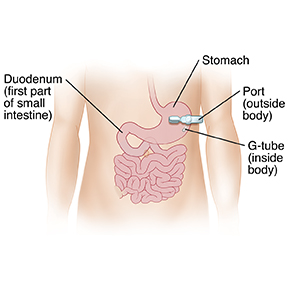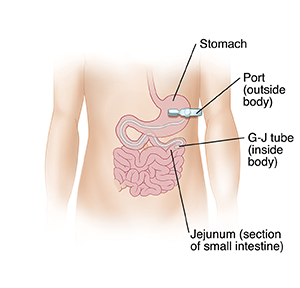If your child is having trouble swallowing food or liquid safely, a feeding tube may be needed. This is a special tube used to send liquid food or medicine straight into your child’s stomach or intestine. A feeding tube is placed during a surgery in the hospital. Liquid food given through the tube is then digested the same as if it were taken by mouth. You’ll be taught how to use, care for, and clean your child’s feeding tube at home. Depending on the type of tube your child has, it may need to be replaced every
Note
Take care to keep the tube from becoming a strangulation risk to your child. Follow your health care team's advice on how to secure the tube safely.
Types of tubes
Your child will get the type of tube that meets their needs. The 2 most common tubes are:
-
Gastrostomy tube (G tube). The end of the G tube is placed through the abdominal wall into your child’s stomach. A port remains outside the child’s body. The G tube is placed so that liquid food is sent straight into your child’s stomach.
-
Gastro-jejunum tube (G-J tube). This tube is often used if your child vomits when large amounts of food are in the stomach. Like the G tube, the G-J tube is placed through the abdominal wall. The end of the G-J tube is put into part of the small intestine called the jejunum. A port remains outside the child’s body. The G-J tube is placed so that liquid food is delivered straight into your child’s small intestine.
Types of feeding
Liquid food or medicines can be put through the feeding tube in 2 ways:
-
Continuous feeding. For this, liquid food is dripped slowly into the tube using a pump. This is used for children who can’t have very much food at one time. This kind of feeding can be done with either a G tube or G-J tube. You will be taught how to give continuous feeding to your child, if needed.
-
Bolus feeding. For this, a meal-sized amount of liquid food can be given several times a day. Bolus feeding is only done with a G tube. You will be taught how to give bolus feeding to your child, if needed.
When to contact your child's doctor
Contact the provider or get medical care right away if:
-
The tube feels loose or comes out.
-
The opening where the tube enters the skin becomes larger.
-
Red, rough tissue forms around the tube site.
-
The tube becomes clogged or blocked and you can’t clear it.
-
The skin around the tube site has redness, swelling, leaking fluid, or sores.
-
You see blood around the tube, in your child’s stool, or in the contents of the stomach.
-
Your child coughs, chokes, or vomits while feeding.
-
Your child’s belly looks bloated or feels hard when gently pressed.
-
Your child has diarrhea or constipation.
-
Your child has a fever
100.4 °F (38 °C) or higher.
Call 911
Call 911 if:
-
Your child has trouble breathing.
Featured in



